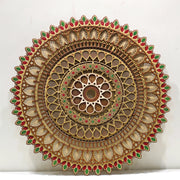
Mandalas are a type of art that has been around for centuries. Originating in India, these beautiful and intricate designs have been used for spiritual and religious purposes for thousands of years. In this post, we’ll take a closer look at the history and symbolism of mandalas, as well as their many uses. From their use in rituals to their modern-day applications, mandalas can be found all over the world. Read on to learn more about this ancient form of art!
What is a Mandala?
A mandala is a complex, symmetrical geometric design that has been used as a symbol in various cultures since ancient times. The word "mandala" comes from the Sanskrit for "circle." Mandalas often contain concentric circles or squares, Julie Hecht writes in Psychology Today, and they can be created freehand or with the help of a compass.
Mandalas have been found in Hinduism, Buddhism, Christianity, Islam, and Native American cultures. In Buddhism, mandalas are used as an aid to meditation. The Dalai Lama has said that each Tibetan Buddhist monastery has a different mandala associated with it.
Native Americans also use mandalas in ceremonies and as a tool for vision quests. Navajo medicine men etch sand paintings as part of healing ceremonies; these sand paintings are often circular in shape and can be seen as examples of Native American mandalas.
Some Jungian psychologists believe that the creation of mandalas can be therapeutic, providing a way to bring order to our lives and access hidden parts of our psyches. Others see mandalas as expressions of our subconscious minds or as symbols of the universe itself.
The history of mandalas
Mandalas have been used throughout history as a way to represent the universe and our place within it. The word mandala comes from the Sanskrit root Manda, meaning "essence," "spiritual center," or "universe." Mandalas have been found in all corners of the world, from ancient cave paintings to Tibetan sand Mandalas.
It is thought that mandalas were first created as a way to help people meditate on the complex relationship between the cosmos and human beings. Throughout history, different cultures have used mandalas to represent their own unique understanding of the universe.
The history of mandalas is closely intertwined with the history of Buddhism. Mandalas are an important part of Buddhist tradition and are used as a tool for meditation. The earliest recorded use of mandalas in Buddhist practice dates back to the 4th century BCE. In Tibet, mandalas are often created out of sand as a way to symbolically represent the transitory nature of life.
Mandalas have also been used in Hinduism and other Eastern religions for centuries. In Hinduism, mandalas are often used as yantras, which are mystical diagrams that are used as tools for contemplation and meditation.
The symbolism of mandalas
Mandalas are symbols that can be found in various cultures all around the world. They are often used as a tool for meditation and can be found in religious texts and art. Mandalas typically consist of concentric circles or squares that contain images or symbols. The word "mandala" comes from the Sanskrit word for "circle".
Mandalas have been used for centuries as a way to focus the mind and promote spiritual and personal growth. The repetitive patterns and symmetrical designs of mandalas can help to bring about a sense of calm and well-being. Mandalas can also be used as a form of self-expression and creativity.
There are many different interpretations of the symbolism of mandalas. Some believe that mandalas represent the universe or the cosmos. Others see mandalas as a representation of the self, with the different elements of the design representing different aspects of the personality. Mandalas can also be seen as a way to connect with our higher selves, or with a higher power.
The use of mandalas is not limited to any one religion or culture. People from all backgrounds can benefit from their beauty and symbolism. Whether you use them for meditation, self-reflection, or simply as a piece of art, mandalas can help you to find your center and achieve inner peace.
How to use mandalas in your life
Mandalas have been used for centuries as a tool for meditation and self-reflection. The word mandala comes from the Sanskrit word for "circle." Mandalas can be created with any material and in any size. They are often drawn or painted as a way to focus the mind during meditation.
Mandalas can also be used as a form of art therapy. The act of creating a mandala can help to reduce stress and anxiety. Mandalas can be used as a way to connect with your innermost thoughts and feelings.
When you look at a mandala, you should allow yourself to really see it. Let your eyes wander around the design and take in all of the details. As you look at the mandala, try to clear your mind of all thoughts. Focus on your breath and let go of any negativity or worry that you may be holding onto.
If you're looking for a way to add more mindfulness to your life, consider using mandalas. Mandalas can help you to relax, reflect, and connect with your innermost self.
Conclusion
Mandalas have a long and storied history, from their Buddhist symbolism to their modern uses in meditation. From being used as an aid for spiritual growth, to being used as a tool for self-expression, mandalas are incredibly versatile and meaningful symbols. Whatever your reasons for using them might be, it is important to remember that everyone’s journey with the mandala is unique; each experience will be different and special in its own way. Take time to explore the history of these ancient symbols and learn how you can use them on your own journey toward inner peace!

